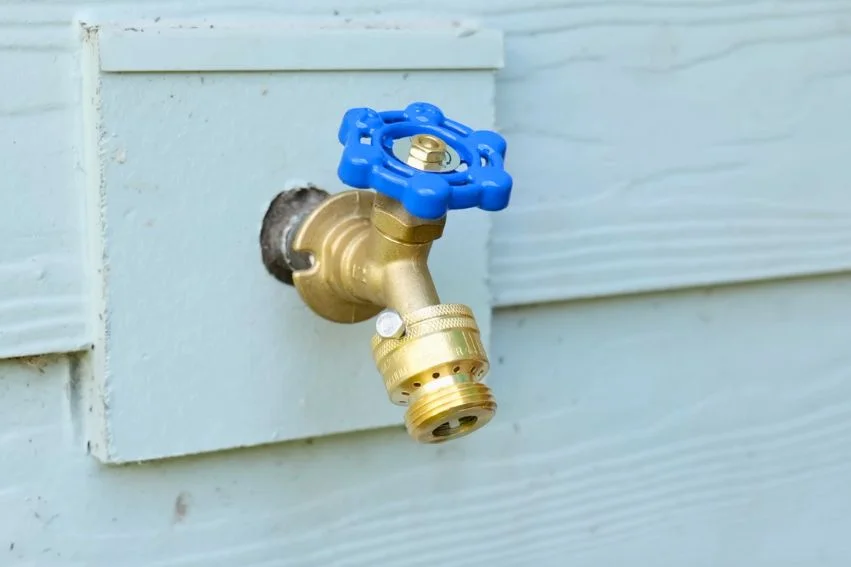Let’s talk about something important in our homes: the outdoor faucet. We usually pay little attention to it until it causes trouble.
If you live where it gets cold in winter, it’s crucial to know if your faucet is frost-free or not. This article will show you how to spot a frost-free tap and check if you have one.
We have summarized the article in 3 points:
Signs that you have a frost-free faucet
Recognizing a frost-free faucet is easy. It has a longer stem and a spout that slopes downward. These faucets stop water from freezing in cold weather. Inside your house, they connect to the water supply with a long branch. When you turn off the tap, it lets all the water drain out of the spout, so there’s no risk of freezing in the pipes.
If you’re unsure whether you have a frost-free faucet or not, here are some signs that can help you determine if you have one:
Here’s a crucial point: having a faucet that slopes downward doesn’t always make it frost-free.
But if you see these signs, you probably do have a frost-free faucet. Checking this helps you keep your pipes safe from freezing in winter.
How to Check if the Faucet You Own is Frost-Free?

You can quickly check if your faucet is frost-free to prevent frozen pipes in cold weather. Here’s how:
Water Flow Test
Please turn on your faucet and let it run for a few minutes. If the water flows smoothly without interruptions, you probably have a frost-free faucet.
Frost-free faucets have a long stem that goes into your house, which keeps the water from freezing in the pipes during winter.
If the water flow stops or slows down, your faucet might be a regular one, which can freeze in the cold.
Temperature Test
In this part, again turn on the faucet and let it run for a bit. Then, touch the faucet handle and spout. If it feels cold, it’s likely a frost-free faucet. These faucets keep the critical parts inside your warm house, preventing freezing in the pipes.
If the handle and spout feel warm, you might have a regular faucet, which is more prone to freezing in cold weather.
Testing like this helps ensure you have a frost-free faucet. It’s essential to avoid costly plumbing issues when temperatures drop.
Common Signs of a Non-Frost-Free Faucet
Living in a place with cold winters means you should know if your faucet is frost-free. Look out for these common signs to check if your faucet is not frost-free:
- Frequent Freezing: If your outdoor faucet keeps freezing in winter, it probably needs to be frost-free. When water inside it freezes, it can damage the faucet, pipes, and your home’s plumbing.
- No Anti-Siphon Device: If your faucet lacks an anti-siphon device, it’s likely not frost-free. An anti-siphon device stops contaminated water from going back into your plumbing, which is vital for your health.
To see if your outdoor faucet has an anti-siphon device, look for a small thing called a vacuum breaker at the top of the tap.
If it’s not there, chances are your faucet isn’t frost-free and doesn’t have an anti-siphon device.
Are Frost-Free Faucets Always Labeled for Hot and Cold Sides?
Yes, frost-free faucets are typically labeled for hot and cold sides. This is important for identifying hot cold faucet sides and preventing any mixing up of the water lines. Look for clear markings to ensure you are correctly connecting the hot and cold water sources to the appropriate sides of the faucet.
FAQ
If you need to become more familiar with frost-free faucets, you may have some questions about them. Here are some frequently asked questions and their answers.
A frost-free faucet is an outdoor faucet designed to prevent water from freezing inside the pipes during cold weather. These faucets have a long stem that extends into the house and connects to the water supply.
You can identify a frost-free faucet by looking inside the spout. You will only notice a metallic stem-like component inside the faucet. On the other hand, the parts of the valve are also visible in non-frost-free taps, which open or close upon turning the valve.
While frost-free faucets are designed to prevent freezing, they can still freeze under certain circumstances. If the faucet is not installed correctly, or if the hose is left attached during freezing temperatures, water can still freeze and damage the faucet.
To maintain your frost-free faucet, you should disconnect the hose during the winter months to prevent water from freezing inside the faucet. You should also make sure the faucet is installed correctly and that there are no leaks.
It’s doable as a DIY project, but it’s crucial to know your plumbing skills. If you’re not confident in your plumbing abilities, it’s safer to bring in a professional. Why? Well, a wrong installation might cause leaks and harm your home.

Leave a Reply